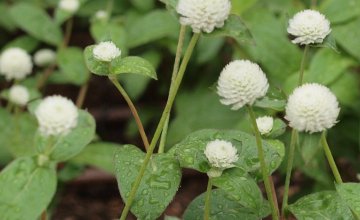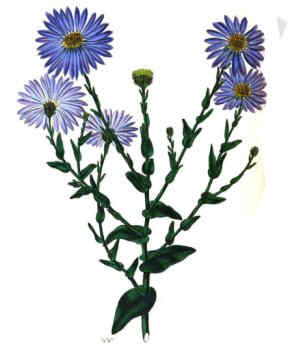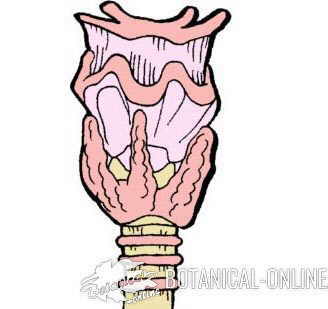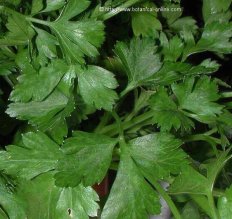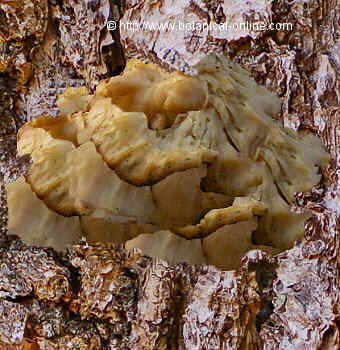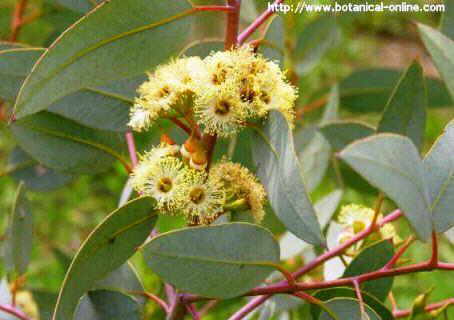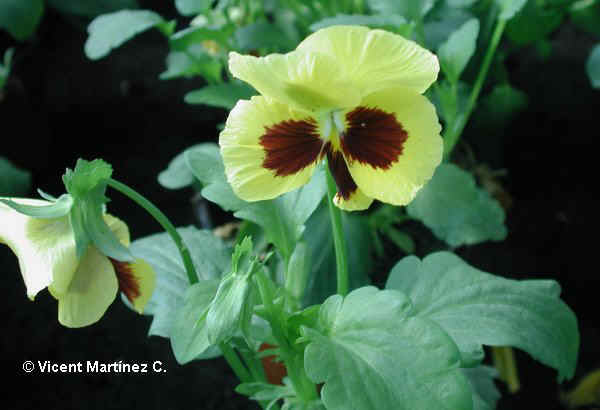Contents
- 1 Medicinal benefits of lavender
- 2 MEDICINAL PROPERTIES OF LAVENDER
- 2.1 How is lavender oil obtained?
- 2.2 How to obtain lavender oil at home?
- 2.3 Lavender oil for the treatment of pain
- 2.4 A plant to heal wounds and to improve the state of the skin
- 2.5 Lavender to remedy the microbial diseases
- 2.6 Infusions of lavender to take care of the nerves
- 2.7 Lavender tea for stomach care
- 2.8 Lavender infusions for respiratory diseases
- 2.9 Is lavender safe?
Medicinal benefits of lavender
Traditional use of lavender
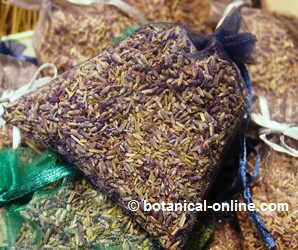 Photograph of a bag of dried lavender flowers. Lavender sachets are used for scenting closed environments, to ward off insects, perfume linen, etc.
Photograph of a bag of dried lavender flowers. Lavender sachets are used for scenting closed environments, to ward off insects, perfume linen, etc.Since ancient times, lavender has been used as a relaxing herb in the bathrooms. The Romans spread the use of lavender oil in bath water.
Whether or not this interpretation is valid, the fact is that lavender has been one of the plants most used in Mediterranean countries, influenced both by the fact that it is a wild plant that grows in great abundance in these countries and the fact that it is very easy to grow.
Folk remedies of lavender
Among the curious folk remedies, we will include the following:
- Helping birth: In the past, some women had the habit of grabbing some branches of lavender during childbirth because they thought that this plant will help the baby’s birth.
- Repelling insects: Cloth bags are manufactured and filled with leaves of this plant to repel flies, mosquitoes or other insects.
- Scenting clothes or rooms: These bags were placed among clothes to give a good aroma and also keep out moths. These same bags are hung in rooms to provide good smell to them.
- Facilitating sleeping: Sometimes the leaves of this plant were tucked into bags placed under the pillow because they were thought to help you fall asleep.
- Killing fleas and other parasites of animals: Lavender oil has been used to remove fleas and other hair parasites from many animals, especially cats and dogs.
- Oil of lavender has been used for a long time to embalm
From a medical point of view, its traditional uses have been very broad. As soothing, as an antiseptic, as a sleep aid, as a digestive, as cicatrizant, etc, its properties have been widely recognized.
MEDICINAL PROPERTIES OF LAVENDER
EXTERNAL USE REMEDIES WITH LAVENDER OIL
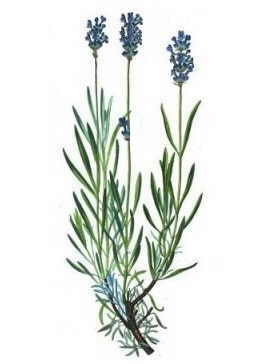 Botanical illustration of lavender
Botanical illustration of lavenderAlthough lavender has been used, it is is still being used in preparations for internal use, external preparations, especially those made with the essential oil are the most commonly used today.
Lavender oil, rich in esters and alcohols (linalool, borneol, citronellol, geraniol, limonene, alpha-pinene, etc) has anti-inflammatory and sedative properties that make it suitable for the treatment of pain.
How is lavender oil obtained?
Lavender essential oil is extracted by distilling the flowers. This work is carried out industrially and oils can be easily purchased from pharmacies or herbalists.
How to obtain lavender oil at home?
Handmade products can be obtained, such as the extract of lavender oil, by means of:
- Marinating fresh lavender flowers with olive oil and exposing the mixture to the hot sun.
- Alcoholic extracts if we macerate flowers of this plant with the same proportion of pure alcohol for a week.
- The principles of lavender can be obtained by infusion of dried flowers at 4% (a tablespoon per cup of water) or using the double amount of tender flowers. This type of preparation is very easy to prepare by the user. However, it is most comfortable and safer to buy the pre-made prepared in a pharmacy or natural shop.
Lavender oil for the treatment of pain
Lavender preparations for the treatment of pain can be used in situations such as:
- Rheumatic pains: They are those that occur as a result of rheumatism. Mainly affecting the joints. (Rub with a few drops of essential oil diluted in olive oil to reduce inflammation and decrease pain.)
- Lumbar pain: In case of lumbago, the same previous treatment can help reduce pain and allow the continuation of normal duties. Rubbing can also be performed with liquid from the infusion of a spoonful of lavender and half a spoon rosemary that has been resting for a couple of hours.
- Torticollis: When the neck hurts and we can not move it, rubbing made with the liquid from the previous preparation can relieve pain, inflammation of the cervical vertebrae and allow the movement back of the neck.
- Headache: If you have headache, produced by the stress, manifested as migraine, a massage on the temples with a few drops of essential oil diluted in olive oil will help ease tension and relieve pain.
- Foot pain: A few drops of lavender oil in a pan of hot water can help to relax the feet and reduce feet fatigue or pain.
* More information on lavender essential oil
A plant to heal wounds and to improve the state of the skin
Mainly cineol, linalool, geraniol, limonene, and sabinene confer lavender antiseptic properties that make it highly effective in the treatment of outer skin lesions, as a cicatrizant.
At the same time, its richness in tannins provides interesting astringent properties to prevent or cure the skin condition.
This applies to the remediation of the following conditions:
- Cuts: Aid to disinfect the wounds, promotes healing and decreases irritation (Wash the affected area with liquid from the infusion for 10 minutes of a teaspoon of dried flowers per cup of water) This treatment is appropriate in other skin lesions such as scratches, chafings or punctures.
- Burns: The previous preparation is ideal for the natural treatment of burns.
- Skin diseases: Lavender has outstanding cicatrizant properties in the care of skin diseases (wash the affected area with the liquid from the infusion for 10 minutes of a teaspoon of dried flowers per cup of water)
- Eczema: Washing eczema with the previous preparation promotes healing.
- Psoriasis: It improves the manifestations of the psoriasis and alleviates itching.
- Stings: Washing the stings of wasps, ticks, fleas, mosquitoes, Asian tiger mosquito and other insects with the same preparation helps reduce swelling and decrease itching.
- Hematomas or bruises: Applied on these lesions, it helps reduce inflammation and facilitate the recovery of the skin. (washings with the liquid from the infusion for 10 minutes of a teaspoon of dried flowers per cup of water) (Mix 5 drops of essential oil of these plants with five tablespoons of olive oil and apply on the affected area)
- Scabies: Lavender oil has been used for scabies, resulting in an effective alternative to the use of commercial chemicals. (Put a few drops of lavender oil in the water bath) (In case of small areas can be applied directly in the affected area some little lavender oil diluted in water)
- Hair loss: Night frictions on the scalp with a few drops of essential oil diluted in olive oil helps to relax the hair follicle and increase blood flow to the area, which can help in the prevention of alopecia.
Lavender to remedy the microbial diseases
Its antiviral, antibacterial and bacteriostatic properties have been proved to be effective in vitro resulting in the elimination and inhibition of many bacteria and viruses responsible for respiratory diseases.
In external use, gargles made with the infusion of a spoonful of dried flowers per cup of water have been effective in the treatment of diseases such as:
- Pharyngitis and laryngitis.
- Tonsils.
- Athlete’s foot; Massaging with lavender oil is a traditional remedy against foot fungus, which can sometimes manifest with symptoms such as burning feet or foot odor. (Mix 5 drops of lavender essential oil with five tablespoons of olive oil and apply on the affected area)
- Other bacterial diseases: In the same way, the antibacterial properties of lavender are used to make appropriate washes to eliminate harmful bacteria, such as the fungus Candida albicans, or some other very well-known bacteria, such as streptococcus, or trichomonas. All of them can be responsible for many vaginal infections. Vaginitis, vaginal flow or candidiasis, that can be remedied with the use of this plant.
INTERNAL USE PREPARATIONS WITH LAVENDER
Infusions of lavender to take care of the nerves
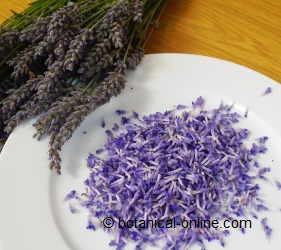 Lavender flowers (Lavandula sp.) are suitable to help calm nerves. They can also be used to flavor recipes such as cakes, biscuits or gelatins.
Lavender flowers (Lavandula sp.) are suitable to help calm nerves. They can also be used to flavor recipes such as cakes, biscuits or gelatins.The antispasmodic and sedative properties of lavender flowers are recognized worldwide. There are countries where lavender infusions or the use of tincture of this plant are prescribed as sedatives and as soft sleeping pills with some frequency.
During the nineteenth century the use of this plant to remedy sleep disorders was something habitual in the homes of aging people in England. Although there are other more recognized natural sedative, calming properties of lavender can be used to reduce nerve problems in circumstances such as:
- Nervous stomachs: The stomach nervousness is one of the causes of bad digestions in many occasions, intestinal spasms, cramps in the stomach, etc.
- The use of preparations of lavender can help “settle the stomach” eliminating many negative manifestations in this body.
- Insomnia: The use of preparations of lavender can help you sleep when insomnia is caused by nerve problems. (infusion for 10 minutes a teaspoon of dried flowers per cup of water. Take 1 cup before bedtime)
- Anxiety: In troubled emotional states, with anxiety, nervousness, moodiness or irritability, lavender can help you calm down. (Infusion for 10 minutes of a teaspoon of dried flowers per cup of water. Take 2 cups a day between meals)
- Motion sickness: motion sickness while traveling by plane, boat or car is produced in many cases by nerve problems. Anxiety or fear of travel ends up producing this sensation.
- The above remedy can be used to reduce or prevent motion sickness while traveling in a moving means of transport. (Infusion for 10 minutes of a teaspoon of dried flowers per cup of water. Take 1 cup water 1 hour before the trip) The same preparation is suitable for the treatment of vertigo that has a nervous origin.
- Hypertension: Lavender helps to slightly decrease blood pressure, especially when this is due to nerve problems. It also has slight diuretic properties, meaning that fosters the elimination of liquids, which also helps lower blood pressure slightly. (Infusion for 10 minutes a teaspoon of dried flowers per cup of water. Take 2 cups per day)
Lavender tea for stomach care
Besides treating stomach nervousness, it has also been proved its choleretic properties (it stimulates the production of bile by the liver) and cholagogue properties (it simulates the production of bile by the gall bladder), making it suitable for heavy digestion due to lack of drainage.
Similarly, the antiseptic properties of this plant are well suited to inhibit the growth of intestinal bacteria responsible for putrefaction that bloat the stomach and cause pain and intestinal gas. (Infusion for 10 minutes of a teaspoon of dried flowers per cup of water. Take 3 cups a day between meals) (In case of putrefaction and abdominal discomfort, have a cup of this tea immediately after meals)
Lavender infusions for respiratory diseases
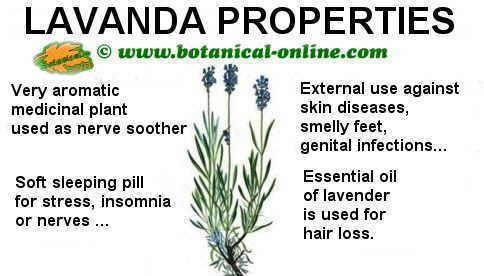 Summary of the main properties of lavender
Summary of the main properties of lavenderIn internal use, these properties have been effective in the treatment of respiratory diseases such as:
- Bronchitis: It reduces inflammation and it is effective in the treatment of cough. (Infusion for 15 minutes of a teaspoon of dried flowers per cup of water. Take hot and sweetened with honey)
- Influenza: It helps reduce the negative symptoms of this disease. (15 minute infusion of a spoonful of dried flowers per cup of water. Take hot and sweetened with honey)
- Cold: It helps eliminate the virus and promotes healing. (15 minute infusion of a spoonful of dried flowers per cup of water. Take hot and sweetened with honey)
Is lavender safe?
Lavender has some contraindications, toxicity and side effects that are very important to know before taking it.
![]() More information on lavender.
More information on lavender.

